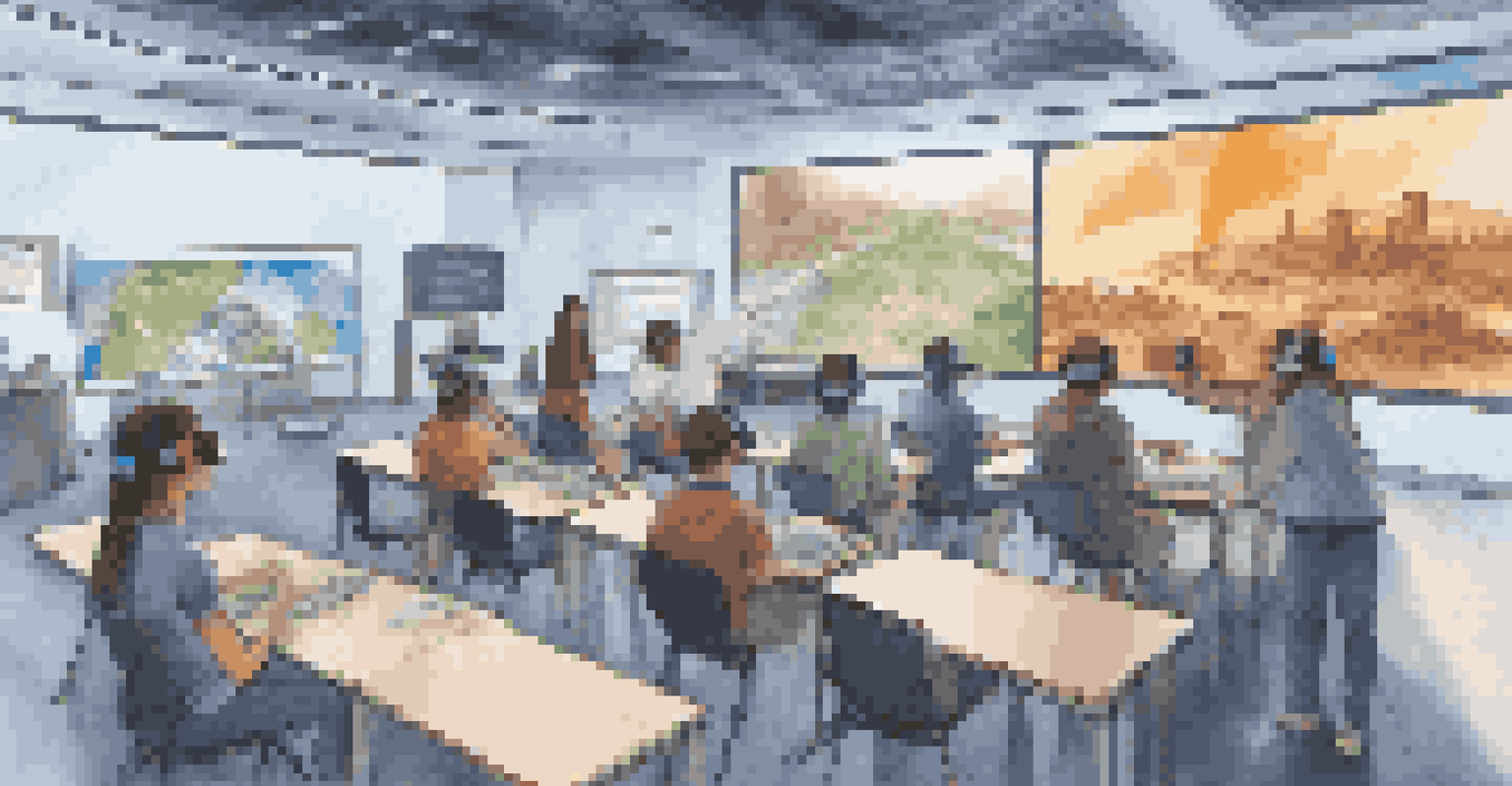Innovative Approaches to Teaching Global Issues in Classrooms

Incorporating Project-Based Learning for Real-World Impact
Project-based learning (PBL) allows students to dive deep into global issues by engaging in hands-on projects that solve real-world problems. For example, students might work on a project to reduce plastic waste in their community, which not only teaches them about environmental issues but also empowers them to make a difference. This method fosters collaboration, critical thinking, and creativity, making learning dynamic and impactful.
Tell me and I forget. Teach me and I remember. Involve me and I learn.
By participating in PBL, students learn to apply their knowledge in practical ways, enhancing their understanding of global challenges. They often feel more connected to the subject matter, as they see the tangible impact of their efforts. For instance, after conducting research and implementing changes, students can witness the positive effects on their environment, reinforcing the importance of civic responsibility.
Moreover, PBL encourages students to develop important skills such as communication and teamwork, which are essential in addressing global issues. As they collaborate with peers, they learn to consider diverse perspectives, mirroring the complex nature of global challenges. This engaging approach not only enriches their education but also prepares them for future roles as informed global citizens.
Utilizing Technology to Explore Global Perspectives
In today's digital age, technology can be a powerful tool for understanding global issues. With resources like virtual reality (VR) and online collaborative platforms, students can experience different cultures and environments firsthand. For example, a VR experience that immerses students in a community affected by climate change can evoke empathy and a deeper understanding of the challenges faced by others around the world.

Additionally, technology enables students to connect with peers from different countries, fostering cross-cultural communication and collaboration. Through shared projects or discussions via video conferencing, students gain insights into global perspectives, broadening their understanding of issues like poverty, inequality, and environmental sustainability. This interaction can help dismantle stereotypes and encourage global citizenship.
Project-Based Learning Empowers Students
Project-based learning engages students in real-world issues, fostering collaboration, critical thinking, and a sense of civic responsibility.
Furthermore, the use of interactive online resources and simulations can enhance students' engagement with global issues. By participating in simulated negotiations on climate policy or exploring data on global health trends, students can analyze real-world scenarios and grasp the complexities of international relations. This hands-on approach to learning cultivates critical thinking and problem-solving skills vital for addressing global challenges.
Integrating Service Learning for Community Engagement
Service learning combines community service with academic instruction, providing a unique opportunity for students to engage with global issues while making a positive impact. For instance, students could partner with local organizations to address food insecurity, allowing them to see the local effects of global issues like poverty and hunger. This method not only reinforces their learning but also cultivates a sense of social responsibility.
Education is the most powerful weapon which you can use to change the world.
By participating in service learning, students develop a deeper understanding of the interconnectedness of local and global challenges. They learn that issues like climate change or human rights violations have tangible effects on their own communities. Through reflection and discussion, students can process their experiences and articulate the broader implications of their service work.
Additionally, service learning encourages students to take ownership of their education, as they actively contribute to solutions. This empowerment fosters a sense of agency, motivating them to become advocates for change in their communities and beyond. Ultimately, service learning nurtures compassionate global citizens ready to tackle pressing issues.
Encouraging Critical Thinking Through Debates and Discussions
Debates and discussions are excellent pedagogical tools for exploring global issues, as they encourage students to think critically and articulate their views. By engaging in structured debates about controversial topics like immigration or climate policy, students are challenged to research, analyze, and defend their positions. This process not only deepens their understanding but also hones their public speaking and argumentation skills.
Moreover, discussions promote an inclusive learning environment where diverse perspectives are valued. Students learn to listen actively and consider opposing viewpoints, fostering empathy and understanding. This exchange of ideas can lead to richer conversations about complex global issues, encouraging students to think beyond their immediate experiences.
Technology Enhances Global Understanding
Utilizing technology, such as virtual reality and online platforms, allows students to connect with diverse cultures and perspectives on global issues.
Additionally, facilitating debates and discussions can help students develop a sense of responsibility for their opinions. As they engage with real-world issues, they become more aware of the implications of their beliefs and actions. This critical engagement prepares them to be informed, active participants in society, ready to tackle global challenges with an open mind.
Using Case Studies to Analyze Global Issues in Depth
Case studies provide a practical framework for students to analyze global issues by examining real-world examples. For instance, exploring the impact of deforestation in the Amazon can help students understand the interconnectedness of environmental, economic, and social factors. This approach encourages them to think critically about the implications of different actions and policies.
Through case studies, students can delve into the complexities of global challenges, analyzing various stakeholders and their motivations. They learn to evaluate the effectiveness of different solutions and consider the ethical implications of their decisions. This analytical process not only deepens their understanding but also develops their ability to think strategically about problem-solving.
Furthermore, using case studies in the classroom helps students draw connections between theoretical concepts and practical applications. They can see the relevance of their studies in the real world and understand the importance of informed decision-making. This method ultimately cultivates a generation of learners who are equipped to tackle global issues with a nuanced perspective.
Creating a Global Issues Curriculum with Interdisciplinary Links
An interdisciplinary approach to teaching global issues can enhance students' learning experiences by connecting different subjects. For example, combining geography, history, and science allows students to explore climate change from multiple angles, fostering a more comprehensive understanding. This integration encourages them to see how global challenges are interconnected and require collaborative solutions.
By designing a curriculum that incorporates various disciplines, educators can engage students' interests and strengthen their critical thinking skills. For instance, analyzing the historical context of a global conflict while exploring its environmental impacts can lead to richer discussions and insights. This approach not only deepens students' understanding but also prepares them for the complexities of real-world challenges.
Storytelling Cultivates Empathy
Incorporating storytelling in education helps students emotionally connect with global challenges, fostering empathy and a sense of responsibility for change.
Moreover, an interdisciplinary curriculum promotes collaboration among educators, allowing them to share expertise and resources. This teamwork can lead to innovative lesson plans and projects that inspire students to think creatively about solutions. Ultimately, a well-rounded curriculum empowers students to become informed global citizens who appreciate the multifaceted nature of global issues.
Fostering Empathy Through Storytelling and Personal Narratives
Storytelling is a powerful tool for teaching global issues, as it helps students connect emotionally with the subject matter. By sharing personal narratives or stories from diverse cultures, educators can foster empathy and understanding of complex global challenges. For example, reading a memoir from a refugee can provide students with a firsthand perspective on the struggles faced by individuals in crisis.
Additionally, storytelling encourages students to reflect on their own experiences and consider how they relate to global issues. This introspection can lead to meaningful discussions about privilege, inequality, and social justice. By exploring these themes through stories, students are more likely to engage with the material on a personal level, fostering a sense of responsibility for creating change.

Moreover, incorporating storytelling into the curriculum can inspire creativity and critical thinking. Students can create their own narratives or multimedia projects that address global issues, allowing them to express their ideas and solutions in innovative ways. This approach not only enriches their learning experience but also empowers them to share their voices and advocate for change.